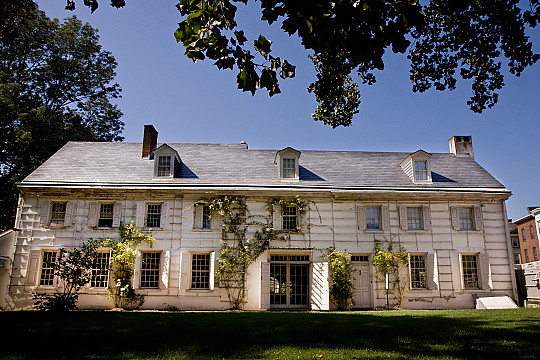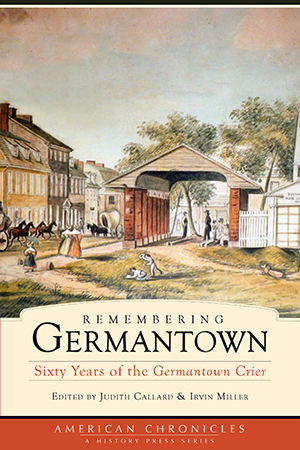Wyck House
6026 Germantown Avenue, Philadelphia, Philadelphia, PA
Dating back to 1690, Wyck is a National Historic Landmark house, garden, and farm in the Germantown neighborhood of Philadelphia that served as the ancestral home to one Philadelphia family for nine generations (1690-1973). Here, traditional Quaker culture is blended with a passion for innovation. The people who lived and worked at Wyck expressed these values through their commitment to education, horticulture, natural history, and preservation. Today, the Wyck Association connects this family and its rich history to our community through programs that focus on history, horticulture, and urban agriculture, using the past as inspiration for the present. Our 2.5-acre, centuries-old site plays an essential role in the life of our 21st-century urban neighborhood, using buildings, landscape, and collections to provide educational, cultural, and nutritional resources for our neighbors and visitors.

Dating to 1690, Wyck is known as one of Philadelphia’s oldest houses, although the original log structure no longer stands. It is an assemblage of structures that evolved over time, but it has not changed since renowned Philadelphia architect William Strickland (1788-1854) renovated the first-floor interiors in 1824. Wyck House grew in parts over the course of the 18th century. The first house on the site was a one-room log structure at the present-day back of the house, built by Swiss-German immigrant Hans Milan in the 1690s. The oldest extant part of the house is the three-bay (3 windows wide) stuccoed stone section that abuts Germantown Avenue.
The House as Seen Today
Built in 1736, this was originally the extent of the house. Today this section houses the front parlor. A larger, four-bay stuccoed stone section was built at the rear in 1771-73, replacing the original log structure. This section houses the library and dining room; before the 1860s it was also sometimes used as a kitchen. The section—now the Conservatory—had served as a driveway and linen weaving shop in the early 18th century (the front and back sections were two separate structures), but was enclosed in the 1790s to create one large house. Entry from the side of a building, rather than off the street, was a typical way to enter an 18th century Germantown home. During these alterations, the exterior Wissahickon schist was also stuccoed and scored in a neoclassical manner, a stylish cosmetic upgrade that disguised the fact that the structure is actually two houses joined together.
The House as Seen Today
Built in 1736, this was originally the extent of the house. Today this section houses the front parlor. A larger, four-bay stuccoed stone section was built at the rear in 1771-73, replacing the original log structure. This section houses the library and dining room; before the 1860s it was also sometimes used as a kitchen. The section—now the Conservatory—had served as a driveway and linen weaving shop in the early 18th century (the front and back sections were two separate structures), but was enclosed in the 1790s to create one large house. Entry from the side of a building, rather than off the street, was a typical way to enter an 18th century Germantown home. During these alterations, the exterior Wissahickon schist was also stuccoed and scored in a neoclassical manner, a stylish cosmetic upgrade that disguised the fact that the structure is actually two houses joined together.
In 1824, Reuben Haines III and his wife, Jane Bowne Haines, commissioned William Strickland (architect of the Second Bank of the United States and the Merchants’ Exchange) to update the house. Strickland removed all the windows facing Germantown Avenue and erected a fireplace in the center of the gable (part of the front hall). Strickland also removed the original fireplace on the house’s north side and installed windows in the first and second stories of the north wall, which opened to the new parterre garden. Perhaps most notably, Strickland dramatically rearranged the interior spaces to create an open plan, allowing light to flood each room and bringing the pleasures of the garden inside.
Additional buildings on site accommodated practical needs, including a coach house (1794), smoke house (circa 1797), ice house (1836), and greenhouse (1914). All of these buildings still stand. The house itself has hardly been altered since William Strickland’s 1824 interior renovation.Twentieth-century architectural efforts focused not on consolidation and growth but rather preservation. Jane Bowne Haines II was particularly devoted to preserving Wyck’s beloved rose garden, which today is considered a living treasure. The nation’s oldest rose garden, features over 70+ varieties of roses growing in their original plan. The National Park Service’s 1933 documentation of Wyck described the house as follows: “An atmosphere of quiet, peace and contentment pervades this charming memorial of our past, and inside and out, Wyck is a delight to all who have a fondness for the old days.” Wyck was added to the National Register of Historic Places in 1971, and was further recognized as a National Historic Landmark in 1991.
The Family
The Family
Hans Milan and his wife had a daughter, names Margaret. Margaret Milan married Dirk Jansen. Their daughter, Catherine, married Caspar Wistar, a German who became a Quaker and amassed a sizable fortune as a button maker, glass-maker, and investor in land. In the next generation, Margaret Wistar married Reuben Haines I, a brewer and merchant of English descent. Their son, Caspar Wistar Haines, continued the family business and married Hannah Marshall, a member of another prominent Quaker family. Wyck passed to Reuben and Jane Bowne Haines, and then to their youngest daughter, Jane Reuben Haines, who lived here until 1911, carefully preserving the house, furnishings, and gardens. In the eighth generation, Jane Bowne Haines II founded the first school of horticulture for women in this country, the Pennsylvania School of Horticulture for Women (today Temple University’s Ambler campus). One brother, Caspar, helped to design the Mexican railway system, while another, Robert, invented a gauge for measuring steel in rolling mills. The last owners, Mary and Robert Haines, were fruit growers; Robert patented a device to press apples for a more natural tasting juice. Wyck’s family descendants remain very involved in the life of their home and community.
A Focus on the 6th Generation
A Focus on the 6th Generation
Wyck’s family personifies Philadelphia’s leadership in business, science, education, social reform, and philanthropy. For example, Reuben Haines, III (1786-1831) had much in common with his colleague from the American Philosophical Society, Thomas Jefferson. Like Jefferson, Reuben was fascinated by the rich possibilities that the new nation offered, from its natural resources to its inventive spirit. When he retired from business at the age of 23, Reuben declared his intent to devote himself to “the pursuit of knowledge and the society of genuine friends.” He conducted experiments in scientific agriculture, led school reforms, and helped to found the Academy of Natural Sciences, the Franklin Institute, and the Pennsylvania Horticultural Society. On the home front, he commissioned his architect friend, William Strickland, to renovate the then-disparate house of many parts into one fashionable Greek Revival country villa. With similar zeal, Reuben’s wife, Jane Bowne Haines, I (1790-1843), joined organizations promoting education for the poor, prison reform, and the abolition of slavery. She also transformed Wyck’s garden in the 1820s into the magnificent display of roses still enjoyed today.
You May Also Like...
Categories
Styles
Share
Original Source through the Wyck Historic House, Garden & Farm
Connections
Be the first to connect to this house. Connect to record your link to this house. or just to show you love it! Connect to Wyck House →






